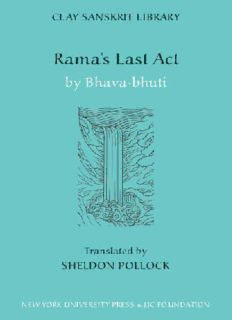
Rama's Last Act (Clay Sanskrit Library) PDF
Preview Rama's Last Act (Clay Sanskrit Library)
THECLAYSANSKRITLIBRARY FOUNDEDBYJOHN﹠JENNIFERCLAY GENERALEDITOR RICHARDGOMBRICH SHELDONPOLLOCK EDITEDBY ISABELLEONIANS SOMADEVAVASUDEVA WWW.CLAYSANSKRITLIBRARY.COM WWW.NYUPRESS.ORG uttararamacaritaQQQ 1 (1, 0) Copyright c bytheCSL. ∞ Allrightsreserved. FirstEdition TheClaySanskritLibraryisco-publishedby NewYorkUniversityPress andtheJJCFoundation. Furtherinformationaboutthisvolume isavailableonthefollowingwebsites: www.claysanskritlibrary.com www.nyupress.org ISBN:----(cloth:alk.paper) ArtworkbyRobertBeer. TypesetinAdobeGaramondProat.:.+pt. XML-developmentbyStuartBrown. EditorialinputfromDánielBalogh&GuyLeavitt. PrintedinGreatBritainbyStEdmundsburyPressLtd, BuryStEdmunds,Suffolk,onacid-freepaper. BoundbyHunter&FoulisLtd,Edinburgh,Scotland. uttararamacaritaR 2 (2, 0) RĀMA’S LAST ACT BY BHAVABHŪTI TRANSLATEDBY SHELDON POLLOCK NEW YORK UNIVERSITY PRESS JJC FOUNDATION uttararamacaritaQQQ 3 (3, 0) LibraryofCongressCataloging-in-PublicationData Bhavabhūti,thcent. [Uttararāmacarita.English&Sanskrit] Rama’slastact/byBhavabhuti; editedandtranslatedbySheldonPollock. p.cm.—(TheClaySanskritlibrary) InEnglishandSanskrit(romanized)onfacingpages; includestranslationfromSanskrit. Includesbibliographicalreferencesandindex. ISBN:----(cloth:alk.paper) .Rama(Hindudeity)—Drama. I.Pollock,SheldonI.II.Title. PK.BU '.–dc uttararamacaritaR 4 (4, 0) Cɴɴ Sanskritalphabeticalorder CSLconventions Preface ForewordbyGirishKʀɴ RAMA’SLASTACT Introduction Prologue ActI:AʜPɪɴɪɴɢEʜɪʙɪɪɴ PreludetoActII ActII:TʜEɴʀɴɪɴPɴʜ·ɪ PreludetoActIII ActIII:TʜSʜ PreludetoActIV ActIV:TʜMɪɴɢKʟʏɴJɴ ActV:TʜYɴɢMɴ’Vʟʀ PreludetoActVI ActVI:TʜRɢɴɪɪɴʜYɴɢMɴ ActVII:Rɴɪɴ ParaphraseofPrakrit(chāyā) Notes Index Sandhigrid uttararamacaritaR 5 (5, 0) uttararamacaritaR 6 (6, 0) ʟɴɴɪɴ ɴʀɪʟʜʙɪʟʀʀ Vowels: aāiīuūr.¯r..l¯.leaioaum. h. Gutturals: kkhgghn˙ Palatals: cchjjhñ Retroflex: t.t.hd. d.hn. Dentals: tthddhn Labials: pphbbhm Semivowels: yrlv Spirants: śs.sh ɢɪɴʀɪʀɴɴɪɪɴ a but vowelsothattaih. ispro- ā,â father nouncedtaihi i sit k luck ī,î fee kh blockhead u put g go ū,û boo gh bighead r. vocalicr,Americanpur- n˙ anger dyorEnglishpretty c chill ¯r. lengthenedr. ch matchhead .l vocalicl,able j jog e,ê,ē made,esp.inWelshpro- jh aspiratedj,hedgehog nunciation ñ canyon ai bite t. retroflex t, try (with the o,ô,ōrope,esp.Welshpronun- tip of tongue turned up ciation;Italiansolo totouchthehardpalate) au sound t.h sameastheprecedingbut m. anusvāranasalizesthepre- aspirated cedingvowel d. retroflex d (with the tip h. visarga,avoicelessaspira- of tongue turned up to tion(resemblingtheEn- touchthehardpalate) glish h), or like Scottish d.h sameastheprecedingbut loch,oranaspirationwith aspirated afaintechoingofthelast n. retroflex n (with the tip elementofthepreceding of tongue turned up to uttararamacaritaR 7 (8, 0) ʀ’ʟ touchthehardpalate) y yes t Frenchtout r trilled,resemblingtheIta- th tenthook lianpronunciationofr d dinner l linger dh guildhall v word n now ś shore p pill s. retroflexsh(withthetip ph upheaval ofthetongueturnedup b before totouchthehardpalate) bh abhorrent s hiss m mind h hood ʟɴɪɴɴɢʟɪʜ TheacuteaccentonSanskritwordswhentheyoccuroutsideofthe Sanskrittextitself,marksstress,e.g.Ramáyana.Itisnotpartoftra- ditionalSanskritorthography,transliterationortranscription,butwe supplyitheretoguidereadersinthepronunciationoftheseunfamiliar words.SincenoSanskritwordisaccentedonthelastsyllableitisnot necessarytoaccentdisyllables,e.g.Rama. ThesecondCSLinnovationdesignedtoassistthereaderinthepro- nunciationoflengthyunfamiliarwordsistoinsertanunobtrusivemid- dledotbetweensemanticwordbreaksincompoundnames(provided thewordbreakdoesnotfallonavowelresultingfromthefusionof twovowels),e.g.Maha·bhárata,butRamáyana(notRama·áyana).Our dotechoesthepunctuatingmiddledot(·)foundintheoldestsurviving samplesofwrittenIndic,theAshokaninscriptionsofthethirdcentury ʙ. ThedeeplayeringofSanskritnarrativehasalsodictatedthatweuse quotationmarksonlytoannouncethebeginningandendofeverydi- rectspeech,andnotatthebeginningofeveryparagraph. ʟɴɪɴɴʀɪ TheSanskrittextisalsopunctuated,inaccordancewiththepunc- tuationoftheEnglishtranslation.Inmid-verse,thepunctuationwill notalterthesandhiorthescansion.Propernamesarecapitalized.Most uttararamacaritaR 8 (9, 0) ʟɴɴɪɴ Sanskrit metres have four “feet” (pāda): where possible we print the commonślokametreontwolines.Thecapitalizationofversebegin- ningsmakesiteasyforthereadertorecognizelongermetreswhereitis necessarytoprintthefourmetricalfeetoverfouroreightlines.Inthe Sanskrittext,weuseFrenchGuillemets(e.g.«kvasam.cicīrs.uh.?»)instead ofEnglishquotationmarks(e.g.“Whereareyouoffto?”)toavoidcon- fusionwiththeapostrophesusedforvowelelisioninsandhi. Sanskrit presents the learner with a challenge: sandhi (“euphonic combination”).Sandhimeansthatwhentwowordsarejoinedincon- nectedspeechorwriting(whichinSanskritreflectsspeech),thelastlet- ter(orevenletters)ofthefirstwordoftenchanges;comparethewaywe pronounce“the”in“thebeginning”and“theend.” InSanskritthefirstletterofthesecondwordmayalsochange;andif boththelastletterofthefirstwordandthefirstletterofthesecondare vowels,theymayfuse.ThishasaparallelinEnglish:anasalconsonant isinsertedbetweentwovowelsthatwouldotherwisecoalesce:“apear” and“anapple.”Sanskritvowelfusionmayproduceambiguity.Thechart atthebackofeachbookgivesthefullsandhisystem. Fortunatelyitisnotnecessarytoknowthesechangesinordertostart readingSanskrit.Forthat,whatisimportantistoknowtheformofthe secondwordwithoutsandhi(pre-sandhi),sothatitcanberecognized orlookedupinadictionary.ThereforeweareprintingSanskritwitha systemofpunctuationthatwillindicate,unambiguously,theoriginal formofthesecondword,i.e.,theformwithoutsandhi.Suchsandhi mostlyconcernsthefusionoftwovowels. InSanskrit,vowelsmaybeshortorlongandarewrittendifferently accordingly. We follow the general convention that a vowel with no markaboveitisshort.Otherbooksmarkalongvoweleitherwitha barcalledamacron(ā)orwithacircumflex(â).Oursystemusesthe macron, except that for initial vowels in sandhi we use a circumflex toindicatethatoriginallythevowelwasshort,ortheshorteroftwo possibilities(eratherthanai,oratherthanau). Whenweprintinitialâ,beforesandhithatvowelwasa îorê, i ûorô, u âi, e uttararamacaritaR 9 (10, 0)
Description: